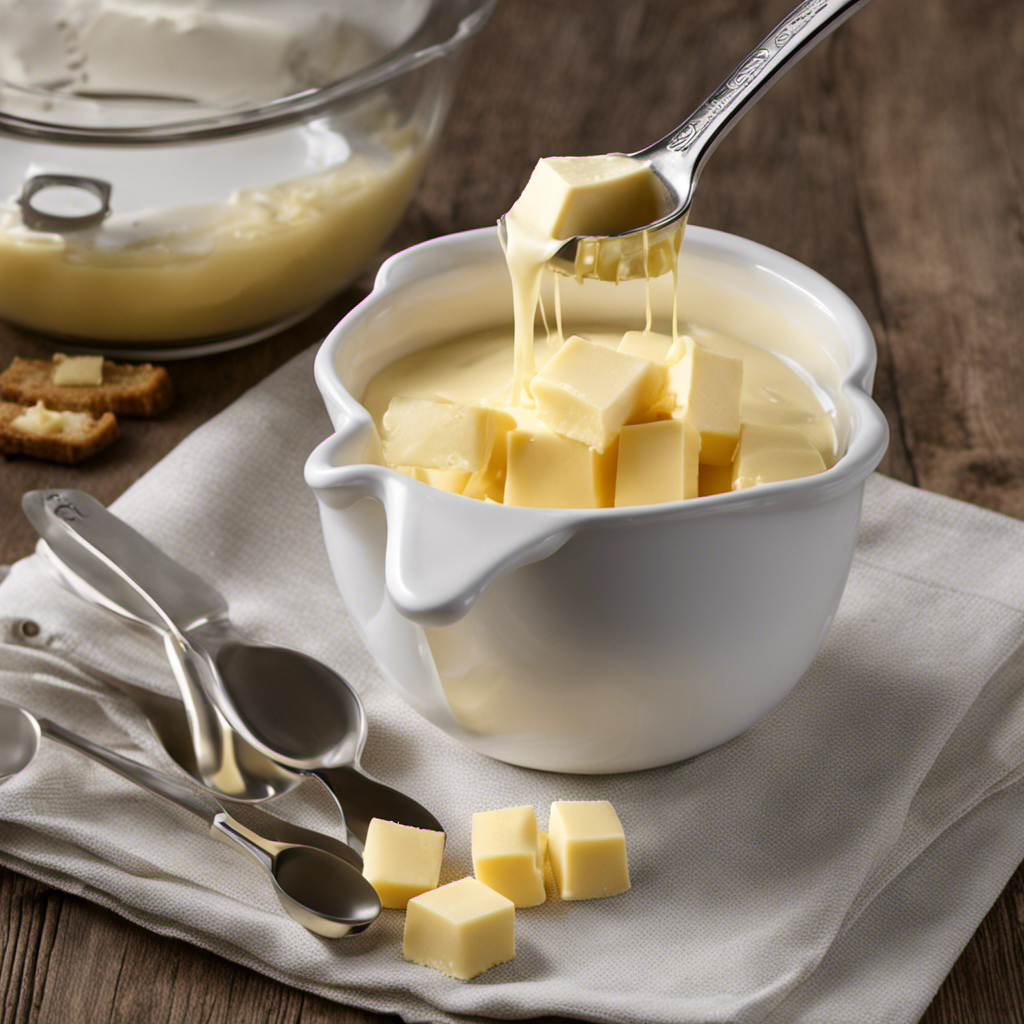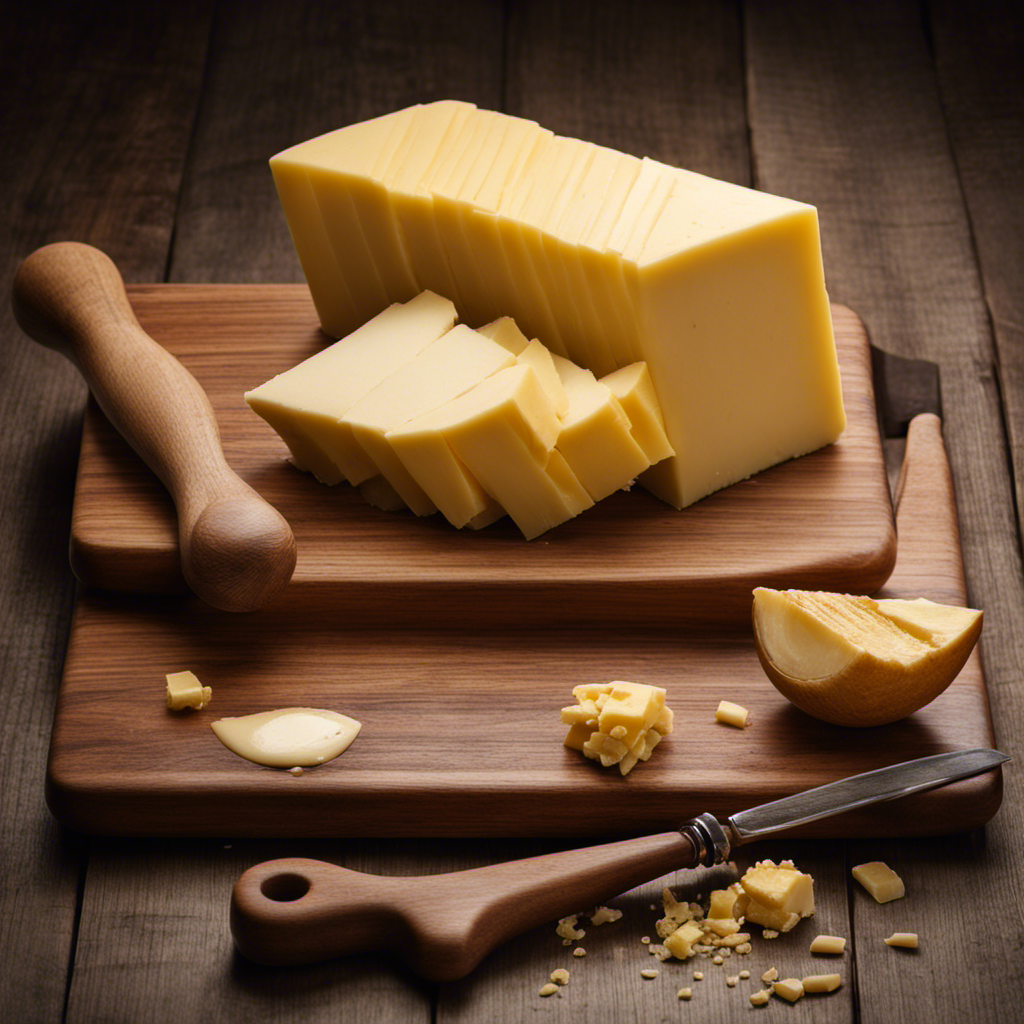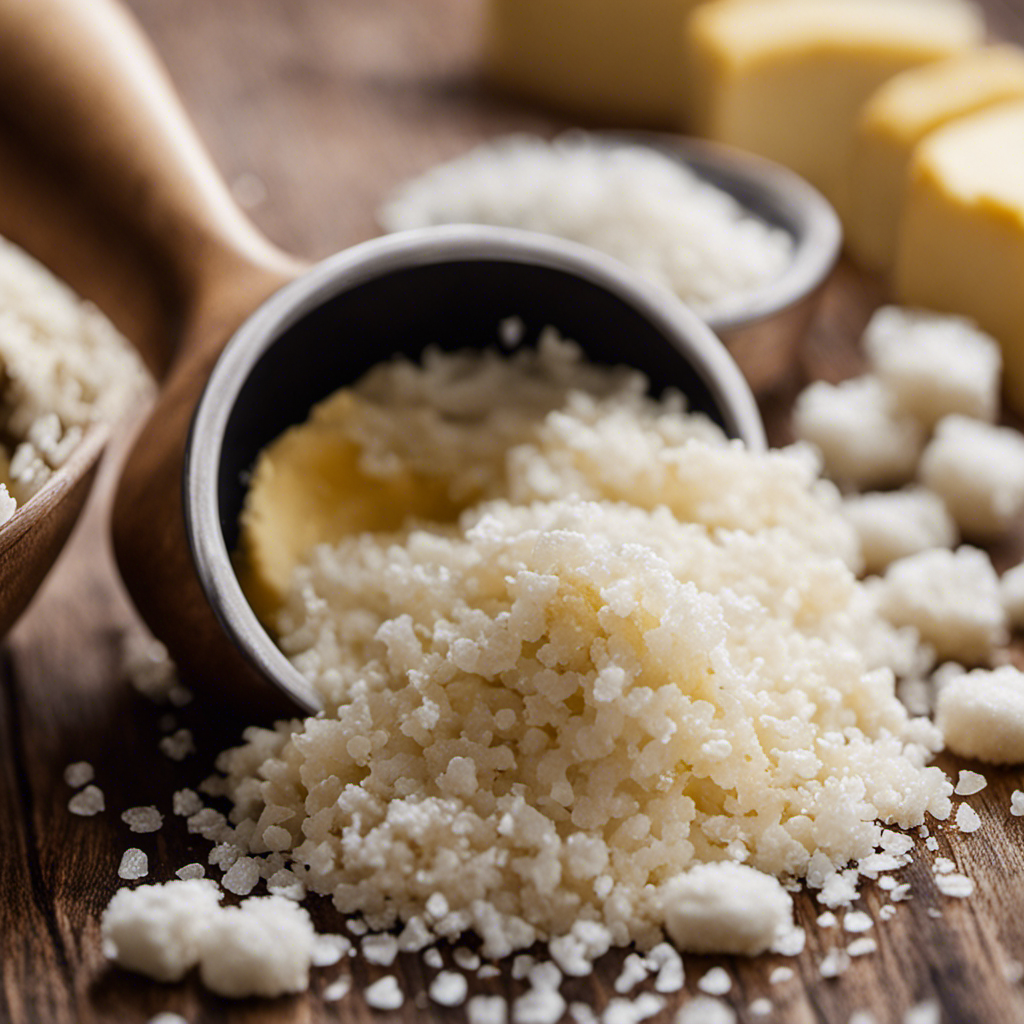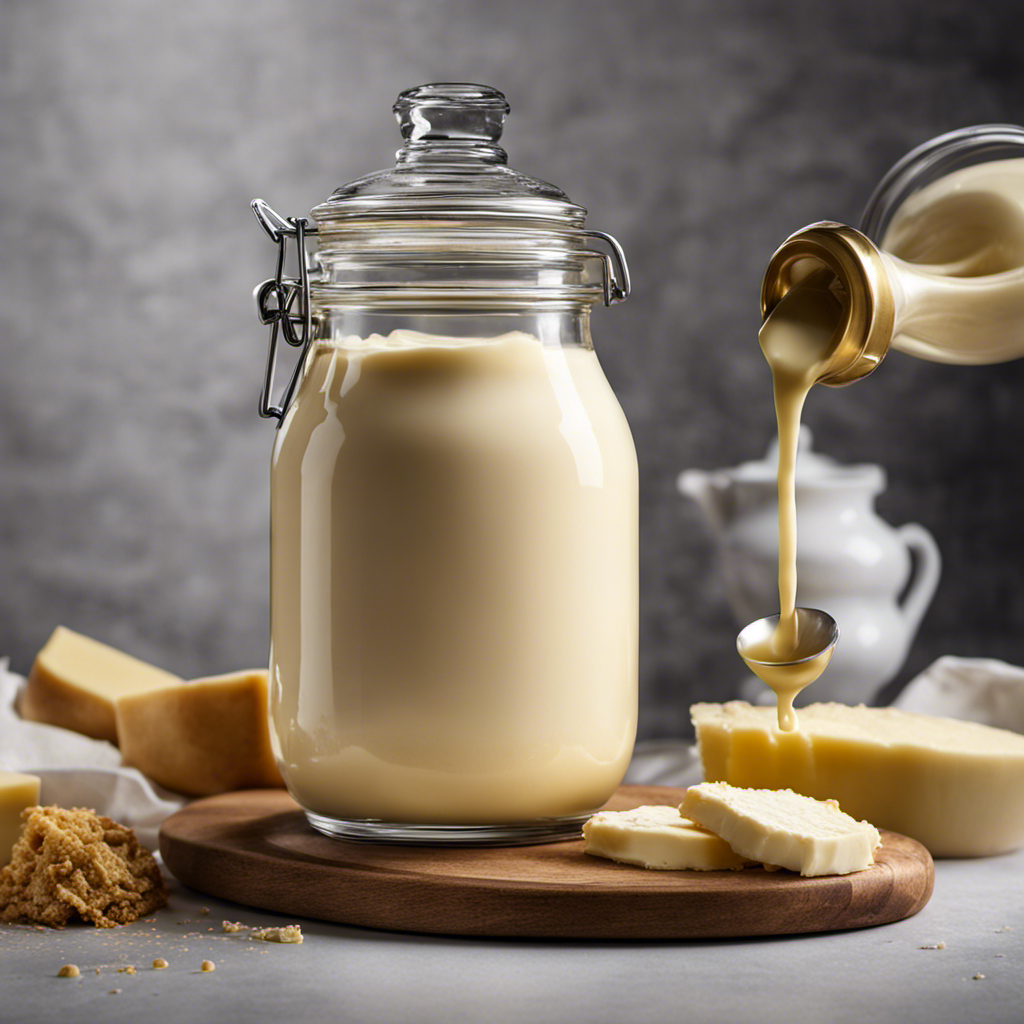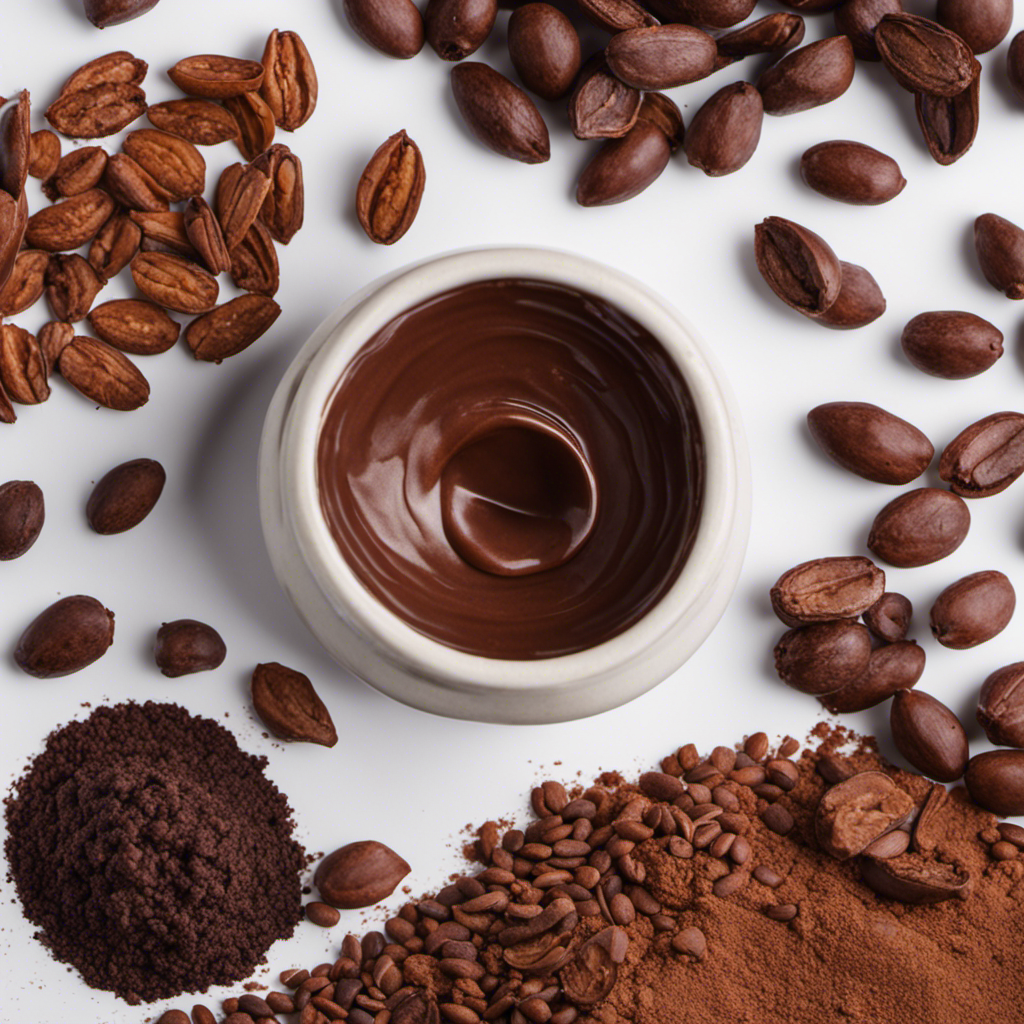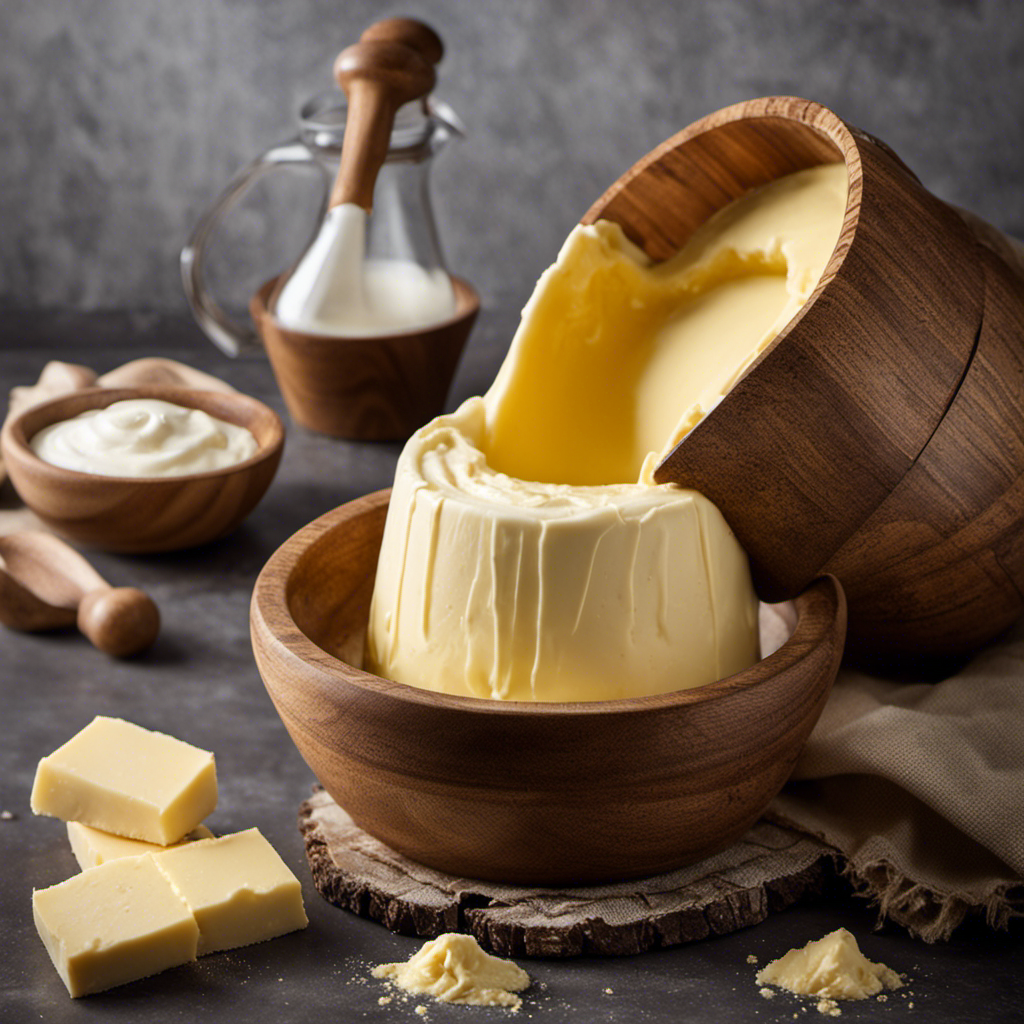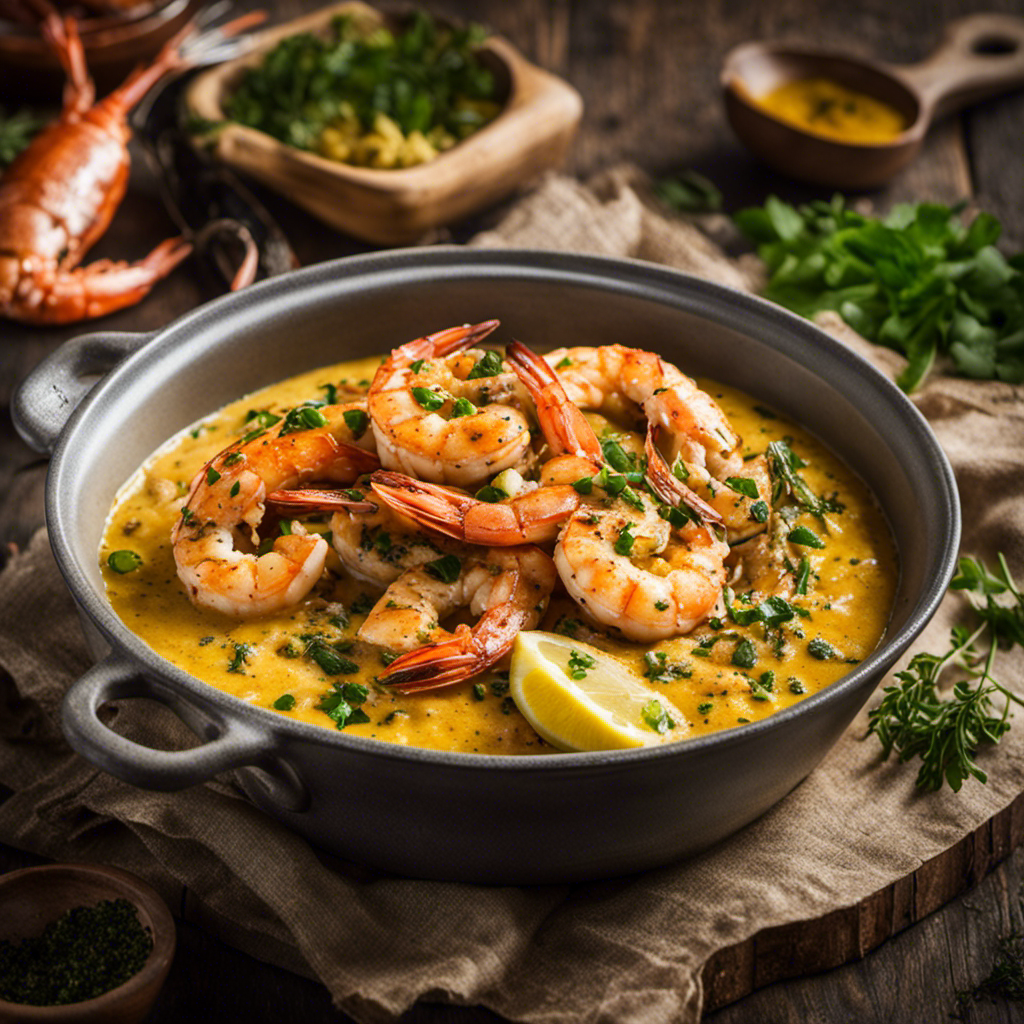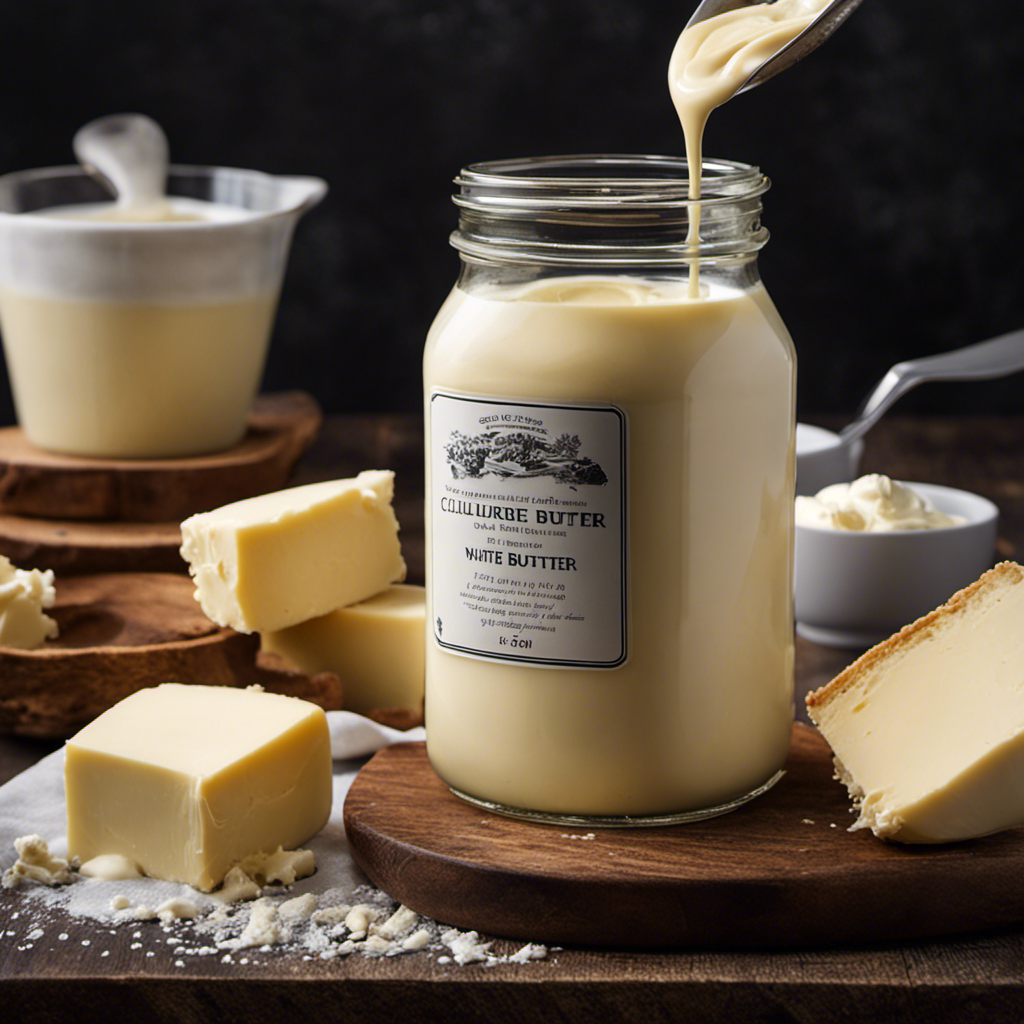Recipes & Culinary Uses
How Many Cups of Butter Equals One Stick: A Comprehensive Guide
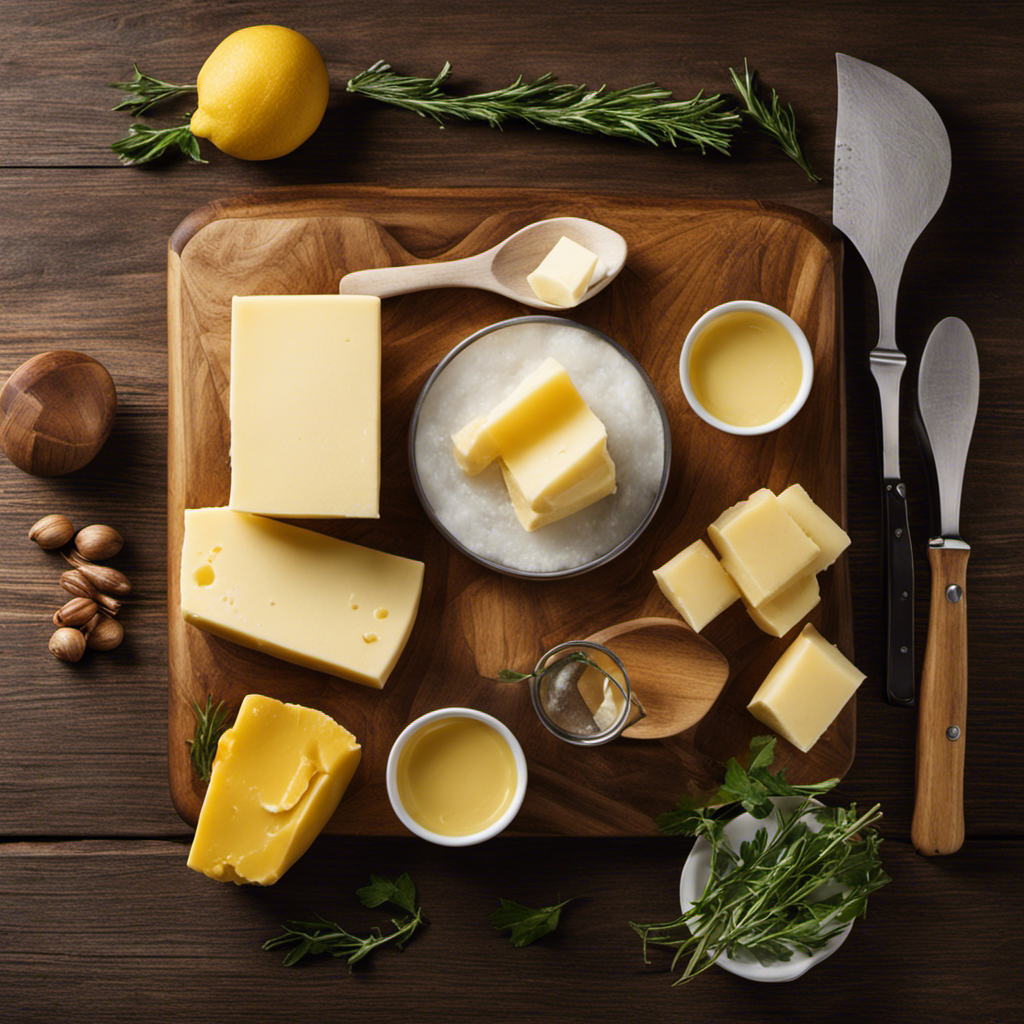
I’ve always wondered about the elusive relationship between a stick of butter and its measurement in cups. It’s like trying to unravel a culinary mystery!
Well, fret no more, because in this article, I’ll dive deep into the world of butter measurements and unravel the secrets behind converting one stick of butter to cups.
So, if you’re ready to solve this buttery enigma and become a master in the kitchen, let’s get started!
Key Takeaways
- One stick of butter is equal to half a cup.
- Accurate measurements of butter are essential for successful recipes.
- Precise measurements maintain consistency in taste, texture, and appearance.
- A standard stick of butter can be converted to cups by dividing the number of sticks by 2.
Understanding the Measurement
You’ll need to understand the measurement in order to determine how many cups are equivalent to one stick of butter. When it comes to measuring equivalents, it’s important to know that one stick of butter is equal to half a cup. This is a standard conversion used in many recipes.
So, if a recipe calls for two sticks of butter, you’ll need one cup. Likewise, if a recipe asks for one cup of butter, you’ll need two sticks. Understanding this conversion will help you accurately measure and convert butter measurements in your recipes.
It’s a simple yet essential piece of knowledge for any baker or cook. So, next time you’re in the kitchen, confidently convert your butter measurements with ease.
The Importance of Accurate Measurements
Accurate measurements are crucial for ensuring the success of your recipe. When it comes to cooking and especially baking, precise measurements are a must. Here are a few reasons why accurate measurements are so important:
-
Consistency: Accurate measurements ensure that you get the same results every time you make a recipe. This is important for maintaining consistency in taste, texture, and appearance.
-
Chemical reactions: Baking is a science, and accurate measurements of ingredients are necessary for the chemical reactions that occur during the baking process. Too much or too little of an ingredient can throw off these reactions and result in a failed recipe.
-
Balance of flavors: Accurate measurements help maintain the balance of flavors in a dish. Too much or too little of an ingredient can overpower or underwhelm the taste buds, affecting the overall enjoyment of the meal.
Butter Conversion Chart
When converting butter measurements in recipes, it’s helpful to know that a standard stick of butter is equivalent to 1/2 cup. This knowledge is essential for achieving accurate and delicious results in your baking endeavors. To further aid in your understanding of butter measurements, here is a handy butter conversion chart:
| Butter Measurement | Cup Equivalent |
|---|---|
| 1 stick | 1/2 cup |
| 1/2 stick | 1/4 cup |
| 1/4 stick | 1/8 cup |
| 1/8 stick | 1/16 cup |
With this chart, you can easily convert butter measurements in your recipes and ensure the perfect balance of flavors and moisture in your baked goods. So, next time you find a recipe calling for butter in a different form, refer to this chart for a seamless and successful baking experience.
How Much Butter in a Stick
It’s useful to know that a standard stick of butter is equivalent to 1/2 cup or 8 tablespoons. This measurement is important to keep in mind when following recipes that require specific amounts of butter.
However, there are alternative butter measurements that can be used if you don’t have a stick of butter on hand. Here are two options to consider:
-
Butter cubes: 1 stick of butter is equal to 4 cubes, which is approximately 1/4 cup or 4 tablespoons.
-
Weight measurements: 1 stick of butter weighs about 1/4 pound or 113 grams.
Converting Sticks of Butter to Cups
To convert sticks of butter to cups, you can simply divide the number of sticks by 2. Understanding butter measurements is essential for accurate butter conversions in recipes. Here are some tips to help you with this process:
-
Always check the recipe for the specific measurement required. Some recipes may call for butter in cups, while others may use sticks.
-
Use a kitchen scale for precise measurements. Weighing the butter will give you the most accurate results.
-
If you don’t have a scale, refer to a conversion chart like the one below:
| Sticks of Butter | Cups |
|---|---|
| 1 | 1/2 |
| 2 | 1 |
| 3 | 1 1/2 |
| 4 | 2 |
- Remember that butter is sold in 1/4 pound sticks, which equals 1/2 cup.
Calculating Butter Equivalents
When it comes to baking, accurate measurements are crucial, especially when it comes to butter. Understanding butter measurement conversions and cup equivalents can make all the difference in your recipes.
In this discussion, we will dive into the topic of butter measurement conversions and explore the cup equivalents for butter, providing you with the knowledge you need to confidently navigate your way through any baking recipe.
Butter Measurement Conversions
Did you know that one stick of butter is equal to 1/2 cup? Understanding butter measurements can be confusing, especially when you come across recipes that require butter to be measured in weight rather than volume. Converting butter measurements to weight is essential for accurate baking.
Here are some key points to help you navigate through the world of butter measurements:
-
When converting butter measurements to weight, one stick of butter weighs approximately 113 grams or 4 ounces. If a recipe calls for a specific weight of butter, use a kitchen scale to measure it precisely.
-
Understanding the different butter measurements, butter is commonly sold in sticks, with each stick measuring 1/2 cup or 8 tablespoons. Butter can also be measured in tablespoons, with 1 stick being equal to 8 tablespoons.
Cup Equivalents for Butter
Understanding butter measurement conversions is important for accurately following recipes. It’s helpful to know that a stick of butter is equivalent to half a cup.
When it comes to measuring butter, precision is key. Here are some tips for accurate butter measurements.
First, ensure that the butter is at room temperature for easy measuring. Use a sharp knife to cut the butter into tablespoon-sized slices or cubes.
If a recipe calls for a specific amount of butter, use a measuring cup or scale to get the exact measurement. For recipes that require smaller amounts of butter, such as teaspoons or tablespoons, use measuring spoons.
Converting Recipes With Butter Measurements
When it comes to baking, sometimes we find ourselves in situations where we need to substitute butter or convert grams to cups in our recipes. In this discussion, I will share some helpful tips for butter substitutions and guide you on how to convert grams to cups accurately.
These key points will ensure that your baked goods turn out just right, even when faced with ingredient challenges.
Butter Substitution Tips
You can easily substitute butter with margarine or oil in your recipes to achieve a similar texture and taste. When it comes to butter alternatives, there are a few options to consider:
-
Margarine: This is a common substitute for butter, and is made from vegetable oils. It has a similar texture to butter and can be used in equal amounts in most recipes.
-
Oil: Another option is to use oil, such as canola or vegetable oil. This is a great choice for recipes that require melted butter, as it can be easily substituted in a 1:1 ratio.
When it comes to butter storage tips, here are a couple of things to keep in mind:
-
Refrigeration: Butter should be stored in the refrigerator to keep it fresh and prevent it from spoiling.
-
Freezing: If you have extra butter that you won’t be using right away, you can freeze it for later use. Just make sure to wrap it tightly in plastic wrap or aluminum foil to prevent freezer burn.
With these butter alternatives and storage tips, you can confidently adapt your recipes and ensure the same delicious results.
Converting Grams to Cups
Converting grams to cups can be tricky, but there are online conversion tools that can help simplify the process.
When it comes to understanding butter measurements, it’s important to know how to convert grams to ounces, as this is commonly used in many recipes. To convert grams to ounces, you can divide the grams by 28.35. Once you have the measurement in ounces, you can easily convert it to cups using a conversion chart or an online tool.
For example, if you have 226 grams of butter, which is equal to 8 ounces, you would then convert it to 1 cup.
Understanding these conversions can make it easier to follow recipes and ensure accurate measurements.
Now, let’s move on to some helpful tips for measuring butter.
Tips for Measuring Butter
To accurately measure butter, it’s helpful to soften it first. Softening the butter allows for easier and more precise measurements. Here are some tips for measuring butter accurately:
-
Softening Methods:
-
Leave the butter at room temperature for 30-60 minutes.
-
Microwave the butter for 5-10 seconds, checking frequently to avoid melting.
-
Measuring Techniques:
-
Use a kitchen scale to measure the exact weight of butter required in a recipe.
-
If a scale is not available, use measuring spoons or a butter dish with markings for different measurements.
Understanding measurements and following these tips will ensure that you add the right amount of butter to your recipes, resulting in delicious and consistent dishes every time.
Common Baking Measurements and Conversions
When baking, it’s important to understand common measurements and conversions for ingredients. Having a good grasp of these measurements ensures accuracy and consistency in your baking.
Here are some key tips for accurate measuring. Firstly, always use the correct measuring tools for dry and liquid ingredients. A liquid measuring cup has a spout for pouring, while dry measuring cups have straight edges for leveling off ingredients.
Secondly, when measuring dry ingredients like flour, spoon it into the measuring cup and level it off with a straight edge. Avoid packing the flour, as it can lead to a dense and dry baked good.
Lastly, remember that conversions are crucial. For example, one stick of butter equals half a cup or 8 tablespoons.
Understanding these measurements and following these tips will help you achieve delicious and successful baking results.
Frequently Asked Questions
Can I Use Margarine or Other Butter Substitutes in Place of a Stick of Butter?
Sure, you can use margarine or other butter substitutes in place of a stick of butter. However, there are pros and cons to consider. Different types of butter substitutes have varying uses in baking.
How Can I Measure Butter if I Don’t Have Measuring Cups or a Kitchen Scale?
To measure butter without measuring cups, you can use common household objects. For example, a stick of butter is equal to 1/2 cup, so you can cut it in half or use a tablespoon.
Can I Substitute Oil for Butter in a Recipe That Calls for a Stick of Butter?
Yes, you can substitute oil for butter in a recipe that calls for a stick of butter. However, keep in mind the different ratios and consider using measuring tools or these tips for measuring butter without tools.
How Can I Convert a Recipe That Uses Grams or Ounces of Butter to Cups?
To convert butter measurements in a recipe to cups, I would use a conversion chart or online tool. It’s important to accurately measure the butter to ensure the recipe turns out as intended.
Are There Any Tricks or Hacks for Easily Measuring a Stick of Butter Without Having to Cut It?
I’ve got a great trick for measuring butter without cutting it! No need for tools. Just use the markings on the paper wrapper to divide the stick into tablespoons or teaspoons. Easy peasy!
Conclusion
In conclusion, it’s crucial to understand the measurement of butter when following recipes. Accurate measurements can make a significant difference in the outcome of your baked goods.
By using a butter conversion chart, you can easily determine how many cups are equivalent to one stick of butter. This knowledge allows you to convert recipes with butter measurements effortlessly and ensure the perfect balance of ingredients.
Remember to always measure butter properly to achieve consistent and delicious results in your baking endeavors.
From sneaky childhood butter licks to penning some of our most popular articles, Jamie’s journey with butter has been lifelong. His culinary background gives him a unique perspective, allowing him to craft mouthwatering articles that educate and tantalize equally. Jamie’s travel adventures revolve around finding the world’s best buttery treats when he isn’t writing.
Recipes & Culinary Uses
How Many Sticks of Butter in 8 Oz: A Quick Guide
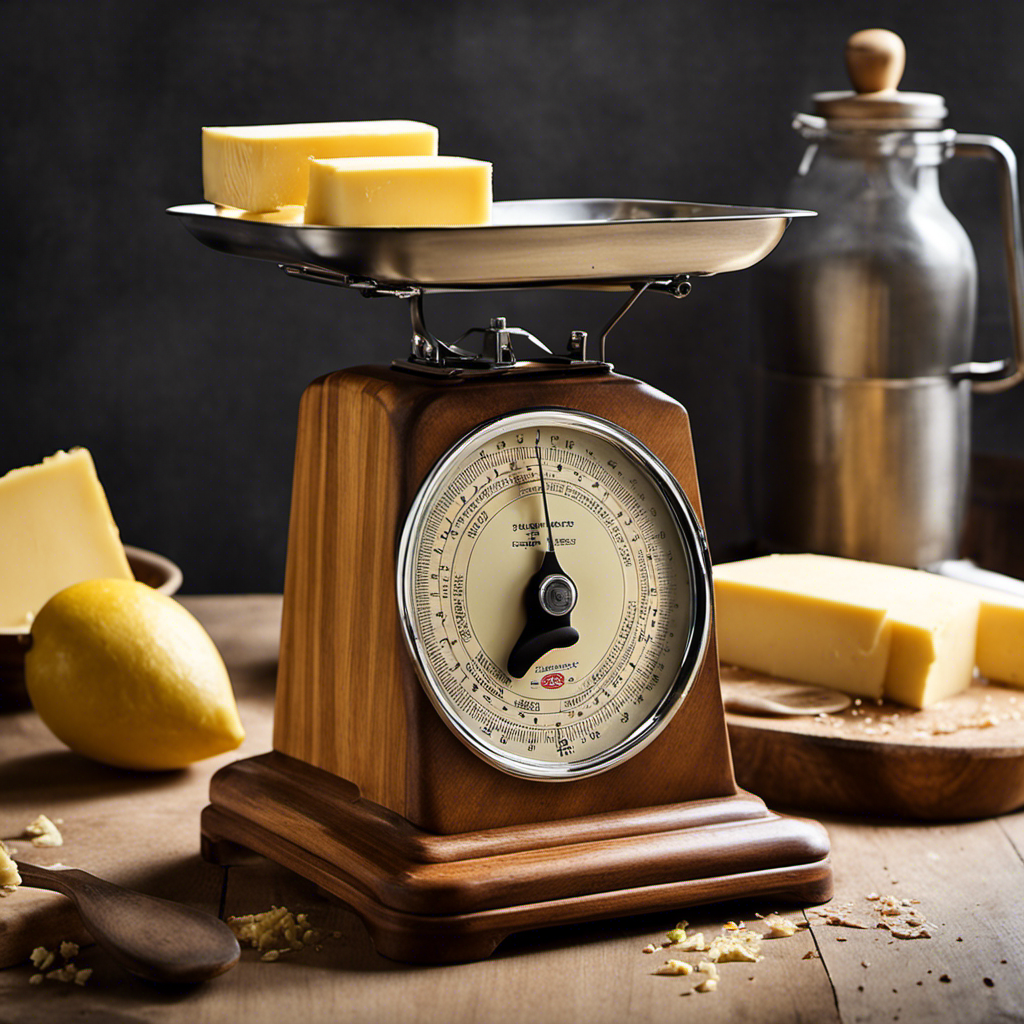
I’ve always been particular about accurate measurements when it comes to baking. Therefore, when I started questioning, ‘How many sticks is 8 oz of butter?’ I decided to do some research to get the answer.
As it turns out, understanding the measurement conversion from ounces to sticks is key. In this article, I’ll break down the standard stick of butter size, explain how to convert ounces to sticks, and provide tips for accurately measuring butter.
Let’s get calculating!
Key Takeaways
- One stick of butter is equal to 8 tablespoons or 1/2 cup.
- Converting ounces to sticks, one stick of butter is equal to 4 ounces.
- Butter is commonly sold in 4-ounce sticks.
- Accurate measurement is crucial for successful culinary endeavors.
Understanding the Measurement Conversion
To understand the measurement conversion, you’ll need to know how many sticks are in 8 oz of butter. Common mistakes when measuring butter can lead to inaccurate results in recipes. One mistake is using the wrong measurement unit. Many recipes call for butter to be measured in sticks, but some people mistakenly measure it in cups or ounces instead. This can throw off the balance of ingredients and affect the final outcome of the dish.
Converting butter measurements for different recipes can be a bit tricky. It’s important to know that one stick of butter is equal to 8 tablespoons or 1/2 cup. So, if a recipe calls for 8 oz of butter, you would need two sticks. Understanding these conversions will ensure accurate measurements and successful cooking.
Now, let’s dive into the standard stick of butter size.
The Standard Stick of Butter Size
The standard stick of butter size is typically 8 ounces. This size has become a common reference point for many home cooks and bakers. However, it is important to note that butter packaging can vary depending on the country and brand.
Here are some variations in butter packaging:
- In the United States, butter is often sold in 4-ounce sticks, which means that 8 ounces would be equivalent to two sticks.
- In Europe, butter is commonly packaged in 250-gram blocks, which is approximately 8.8 ounces.
- Some brands also offer butter in tubs or tubular containers, which may not follow the standard stick size.
The historical origins of the stick of butter size are not well-documented. However, it is believed that the stick size was introduced in the early 20th century to make it easier for consumers to measure and use butter in recipes.
Converting Ounces to Sticks
Converting ounces to sticks can be a helpful way to measure butter for your recipes. Butter is commonly sold in sticks, which are a convenient and easy-to-use measurement for baking.
To convert ounces to sticks, you need to know that one stick of butter is equal to 4 ounces. Therefore, if you have 8 ounces of butter, you would have 2 sticks. This conversion is based on the standard packaging of butter, which typically comes in 4-ounce sticks.
The history of butter packaging has had a significant impact on measurement standards. In the past, butter was often sold in bulk or wrapped in different sizes, making it difficult to measure accurately. The introduction of standardized butter packaging has made it easier for bakers to follow recipes precisely and achieve consistent results.
Calculating the Number of Sticks in 8 Oz of Butter
Calculating how many sticks are in 8 ounces of butter is a straightforward process. To help you understand this calculation, here are a few key points:
-
Converting grams to sticks: If you have a recipe that calls for grams of butter and you want to measure it in sticks, you can use a conversion chart. Simply find the number of grams in your butter, then refer to the chart to determine how many sticks it is equivalent to.
-
Alternative measurements for butter: Besides sticks and ounces, butter can also be measured in tablespoons, cups, or grams. It’s important to know these alternative measurements, especially if you don’t have a stick of butter on hand.
-
Tips for measuring butter accurately: Measuring butter can sometimes be a bit tricky, as it’s often sold in blocks or tubs. To ensure accuracy, use a kitchen scale to weigh the desired amount or refer to the measurement markings on the packaging.
Understanding these concepts will not only help you calculate the number of sticks in 8 ounces of butter, but also provide you with the knowledge to measure butter accurately in various situations.
Now, let’s delve into some tips for measuring butter accurately.
Tips for Measuring Butter Accurately
Measuring butter accurately can be made easier by using a kitchen scale or referring to the measurement markings on the packaging.
When it comes to measuring butter alternatives, a kitchen scale is a valuable tool. It allows for precise measurements in grams or ounces, ensuring accuracy in recipes. By placing a bowl on the scale, zeroing it, and then adding the desired amount of butter alternative, one can easily measure the exact quantity needed. This method eliminates the guesswork and guarantees consistent results.
Alternatively, some butter alternatives come in pre-measured sticks or cups, which have measurement markings on the packaging. These markings indicate the amount of butter alternative contained in each stick or cup, making it effortless to measure the required quantity.
Whether using a kitchen scale or relying on the measurement markings, accurately measuring butter alternatives is crucial for successful culinary endeavors.
Frequently Asked Questions
Can I Use a Different Size Stick of Butter for This Measurement Conversion?
Yes, you can use a different size stick of butter for this measurement conversion. However, it is important to note that using different stick sizes may affect the accuracy of the butter measurement.
How Do I Convert Ounces to Grams?
How do I convert ounces to grams? Converting ounces to milliliters is a straightforward process, but converting grams to pounds requires a different formula. Let’s explore the steps and calculations involved in each conversion.
What Other Ingredients Can I Use as a Substitute for Butter in This Recipe?
When looking for substitutes for butter in a recipe, there are several vegan butter alternatives available. These options can be used as a replacement for butter to create a similar texture and taste in your dish.
Can I Use Salted Butter Instead of Unsalted Butter for This Measurement?
Using salted butter instead of unsalted butter can alter the taste and saltiness of the dish. To determine the right amount of salt, consider the salt content in the recipe and adjust accordingly.
How Do I Measure Butter Without Using a Scale or Measuring Cup?
To measure butter without a scale or measuring cup, you can use the markings on the butter wrapper or a kitchen scale. Adjusting the amount of butter in a recipe depends on personal preference or dietary restrictions.
Conclusion
In conclusion, understanding the measurement conversion of butter is essential for accurate baking and cooking.
Converting ounces to sticks can be easily done by knowing the standard stick size. Based on my research, one interesting statistic is that a standard stick of butter weighs 4 ounces.
Therefore, to calculate the number of sticks in 8 ounces of butter, one would divide 8 by 4, resulting in 2 sticks.
This statistic highlights the importance of precise measurements to achieve desired culinary results.
Diana’s meticulous nature and editorial prowess set the gold standard for our content. With over a decade in the culinary and publishing industries, her guidance ensures that every article perfectly blends information and entertainment. A culinary experimenter, Diana loves whipping up new butter-based concoctions in her kitchen.
Recipes & Culinary Uses
How Many Sticks of Butter Equal a Pound: A Simple Guide

As a baker who bakes at home, I frequently ponder the question of how many sticks of butter make up a pound. This information is essential when following recipes and aiming for the desired texture and flavor.
In this article, we’ll explore the conversion ratio of sticks of butter to pounds, delve into the world of butter packaging and measurements, and provide you with common conversions for baking.
So, let’s dive in and uncover the secrets of accurate butter measurement!
Key Takeaways
- The common conversion ratio is 4 sticks of butter to 1 pound.
- 1 pound of butter is equivalent to 4 sticks.
- 2 sticks of butter is half a pound.
- 1 cup of butter is equal to 2 sticks or 16 tablespoons.
Conversion Ratio: Sticks of Butter to Pounds
There’s a common conversion ratio of 4 sticks of butter to 1 pound. This ratio is widely used in cooking and baking. It helps to know this conversion when following recipes that call for butter in pounds or sticks.
For example, if a recipe requires 1 pound of butter, you can easily determine that it is equivalent to 4 sticks. Similarly, if a recipe calls for 2 sticks of butter, you can calculate that it is half a pound.
It’s important to note that butter should be stored properly to maintain its freshness. To keep butter at its best, store it in the refrigerator in an airtight container. You can also freeze butter for longer storage, but make sure to wrap it tightly in foil or freezer-safe bags to prevent freezer burn.
Butter Packaging and Measurements
To figure out how much butter is in a pound, you’ll need to know how the packaging and measurements are done. Butter packaging design and the types of butter sold can vary, but here are some common factors to consider:
- Butter is typically sold in sticks, which are usually wrapped in wax paper or foil.
- Each stick of butter is usually 1/2 cup or 8 tablespoons.
- Butter can also be sold in blocks or tubs, which may have different measurements indicated on the packaging.
- European butter is often sold in 250g blocks, which is slightly less than 1/2 pound.
- Some butter packaging may also include weight measurements in grams.
Understanding the different packaging options and measurements is important when converting butter for recipes.
Now, let’s explore some common butter conversions for baking.
Common Butter Conversions for Baking
If you’re looking to convert butter for baking, a common measurement is 1 cup of butter, which is equal to 2 sticks or 16 tablespoons.
When it comes to butter measurement tips, it’s important to know these conversions to ensure accurate results in your recipes. Converting butter measurements can be crucial in achieving the right texture and flavor in your baked goods.
Understanding the equivalencies can save you time and effort in the kitchen. For example, if a recipe calls for 1/2 cup of butter, you can simply use 1 stick of butter. Similarly, if you need 1/4 cup of butter, you can use half a stick or 4 tablespoons.
Knowing these conversions will help you navigate through various baking recipes with ease and confidence.
How to Convert Sticks of Butter to Pounds
Converting sticks of butter to pounds can be done by multiplying the number of sticks by 0.25. This is a simple and quick calculation that allows you to easily convert butter measurements. However, it’s important to note that different butter types may have slight variations in weight.
To accurately measure butter, you can use the following tools:
- Kitchen scale: This is the most precise way to measure butter, as it gives you an exact weight.
- Measuring cups: Use a liquid measuring cup for softer butters, and a dry measuring cup for harder butters.
- Butter dish: Some butter dishes have markings on the side, indicating the weight of the butter.
Tips for Accurate Butter Measurement
For more precise measurements, you can try using a kitchen scale to accurately measure the weight of your butter. This is especially helpful when you need to soften a specific amount of butter for baking or cooking.
Softening butter is crucial for achieving the right texture and consistency in your recipes. If you don’t have a kitchen scale, there are alternative measurements you can use.
One stick of butter typically weighs around 113 grams or 4 ounces. So, if you need half a cup of butter, you can use one stick, and if you need one cup of butter, you can use two sticks.
Remember to let the butter sit at room temperature for about 30 minutes before using it. This will make it easier to work with and ensure even mixing in your recipes.
Frequently Asked Questions
Can I Use Margarine Instead of Butter in Baking Recipes?
Yes, you can use margarine instead of butter in baking recipes. However, keep in mind that margarine may have a different texture when baked compared to butter. Experimentation may be needed to achieve desired results.
How Many Tablespoons Are in a Stick of Butter?
There are 8 tablespoons in a stick of butter. Knowing this conversion is helpful when substituting butter in recipes or when following a recipe that calls for a specific amount of butter in tablespoons.
Is It Possible to Convert Grams of Butter to Pounds?
Converting grams of butter to pounds is possible. However, there is no standard conversion rate for butter from grams to pounds. It depends on the density of the butter.
What Is the Shelf Life of a Stick of Butter?
The shelf life of a stick of butter depends on proper storage. It can last for several weeks in the refrigerator and up to a year in the freezer.
Are There Any Alternative Measurements for Butter Besides Sticks and Pounds?
When it comes to butter, there are alternative measurements besides sticks and pounds. Butter conversion charts can help you determine the right amount for your recipe. It’s important to have accurate measurements for baking.
Conclusion
Given the conversion ratio of 1 pound of butter equaling 4 sticks, it is clear that butter packaging and measurements can be confusing. However, with common conversions for baking and a simple method to convert sticks of butter to pounds, achieving accurate measurements is possible.
While it may seem trivial, accurately measuring butter can make a significant difference in the outcome of your baked goods. So, next time you reach for that stick of butter, remember the importance of precision and embrace the irony of this seemingly small task.
Sunny’s articles radiate enthusiasm, much like her sunny disposition. As our resident “Butter Geek”, she delves deep into the latest butter trends, ensuring our readers are always in the know. Beyond her writing, Sunny’s passion lies in exploring vegan butter alternatives and hosting butter-tasting soirées.
Recipes & Culinary Uses
How Many Ounces in a Cup of Butter: A Simple Guide

Ever thought about how many ounces are in one cup of butter?
Well, I’ve got the answer for you! In this article, I will explain the conversion of butter measurements and help you understand the relationship between cups and ounces when it comes to measuring butter.
With this information, you’ll be able to confidently convert cups to ounces for any butter recipe.
So let’s dive in and demystify the world of butter measurements!
Key Takeaways
- Accurate conversion equivalents are crucial in cooking and baking.
- Understanding the relationship between cups and ounces in butter is essential for successful recipes.
- Butter measurements can vary depending on temperature and type, so it’s important to double-check measurements.
- Conversion charts and knowledge of measurement equivalents help ensure accuracy when measuring butter.
Conversion of Butter Measurements
I know that there are 8 ounces in a cup of butter. When it comes to measuring butter, it’s important to have accurate conversion equivalents. Converting butter measurements accurately can be crucial in cooking and baking. Understanding the butter measurement equivalents can save you from any recipe mishaps.
For example, if a recipe calls for 1/2 cup of butter, it means you need 4 ounces of butter. Similarly, if a recipe requires 1/4 cup of butter, you’ll need 2 ounces. It’s essential to have this knowledge to ensure your recipes turn out as intended.
Understanding Ounces in a Cup of Butter
It’s important to understand the measurement of ounces when using butter in recipes. Butter is often measured in ounces, and it’s crucial to know how to convert these measurements accurately.
A cup of butter is equal to 8 ounces or 2 sticks of butter. This measurement is essential because it determines the correct amount of butter needed for a recipe.
To convert butter measurements, remember that 1 stick of butter is equal to 4 ounces or 1/2 cup. So if a recipe calls for 1 cup of butter, you’d need 2 sticks or 8 ounces.
Understanding butter measurements and being able to convert them accurately will help ensure the success of your recipes and delicious results in the kitchen.
The Relationship Between Cups and Ounces in Butter
To accurately measure butter in recipes, it’s important to understand the relationship between cups and ounces. Here are some important tips to help you convert butter measurements:
- 1 cup of butter is equal to 8 ounces or 2 sticks of butter.
- If a recipe calls for 1/2 cup of butter, you’ll need 4 ounces or 1 stick of butter.
- For 1/4 cup of butter, you’ll need 2 ounces or 1/2 stick of butter.
Knowing these butter measurement equivalents will ensure accuracy in your recipes.
When measuring butter in cups and ounces, it’s important to remember that butter can vary in density depending on its temperature. Softened butter will take up more space in a measuring cup compared to cold butter. So, if a recipe calls for melted butter, it’s best to measure it in its melted state rather than trying to convert it from solid form.
Now that we understand the relationship between cups and ounces, let’s dive into the details of measuring butter in cups and ounces.
Measuring Butter in Cups and Ounces
When measuring butter in recipes, I find it helpful to understand the conversion between cups and ounces. This knowledge ensures that I add the right amount of butter to my dishes, resulting in a well-balanced and delicious outcome.
To measure butter accurately, I often refer to a conversion chart that tells me how many ounces are in a cup. Typically, there are 8 ounces in a cup of butter. However, it’s important to note that butter can also be measured in teaspoons and tablespoons.
For instance, one stick of butter is equal to 8 tablespoons or 1/2 cup. Knowing these conversions is crucial for achieving the desired taste and consistency in my recipes.
Accurate butter measurements truly make a difference in the final outcome of any dish.
Converting Cups to Ounces for Butter Measurement
I find it helpful to understand the conversion between cups and ounces for measuring butter in recipes and ensuring accurate measurements.
When converting butter measurements from cups to ounces, it’s important to remember that different types of butter have different densities, which can affect the conversion factor. However, as a general guideline, here is a rough conversion:
- 1 cup of butter is approximately equal to 8 ounces.
- 1 stick of butter is equal to 1/2 cup, which is approximately 4 ounces.
- 1 tablespoon of butter is equal to 1/8 cup, which is approximately 1 ounce.
Keep in mind that these conversions are approximate and may vary slightly depending on the brand and type of butter you’re using. It’s always a good idea to double-check your measurements to ensure accuracy in your recipes.
Frequently Asked Questions
Can I Use Margarine Instead of Butter in Recipes That Call for Cups and Ounces of Butter?
Yes, you can use margarine instead of butter in recipes that call for cups and ounces of butter. Margarine is a common alternative option for measuring butter in baking.
How Do I Convert Tablespoons to Ounces When Measuring Butter?
Converting tablespoons to ounces when measuring butter can be a bit tricky. But fear not! I’ve got the butter measurement equivalents down to a science. Let me break it down for you.
What Is the Difference Between Salted and Unsalted Butter When Measuring Cups and Ounces?
The difference between salted and unsalted butter when measuring cups and ounces is that salted butter already contains salt, while unsalted butter does not. Margarine can be used as a substitute for butter, but it may have different texture and taste.
Can I Use a Kitchen Scale to Measure Butter Instead of Using Cups and Ounces?
Using a scale to measure ingredients in baking has many benefits. It allows for precise measurements, ensuring accurate results. Plus, it’s a time-saver and reduces the need for multiple measuring cups.
Are There Any Tips or Tricks for Accurately Measuring Butter in Cups and Ounces Without a Scale?
When measuring butter without a scale, there are a few tips for accurate measurement. One cup of butter is equal to 8 ounces. Remember to soften the butter before measuring for more precise results.
Conclusion
In conclusion, knowing how to convert butter measurements is crucial in cooking and baking. Remember the adage ‘A cup of butter, 8 ounces it shall be.’
By understanding the relationship between cups and ounces, you can accurately measure butter for your recipes. Whether you need to convert cups to ounces or vice versa, knowing the precise measurements will ensure your dishes turn out perfectly every time.
So next time you’re in the kitchen, don’t forget to measure your butter with precision.
From sneaky childhood butter licks to penning some of our most popular articles, Jamie’s journey with butter has been lifelong. His culinary background gives him a unique perspective, allowing him to craft mouthwatering articles that educate and tantalize equally. Jamie’s travel adventures revolve around finding the world’s best buttery treats when he isn’t writing.
-
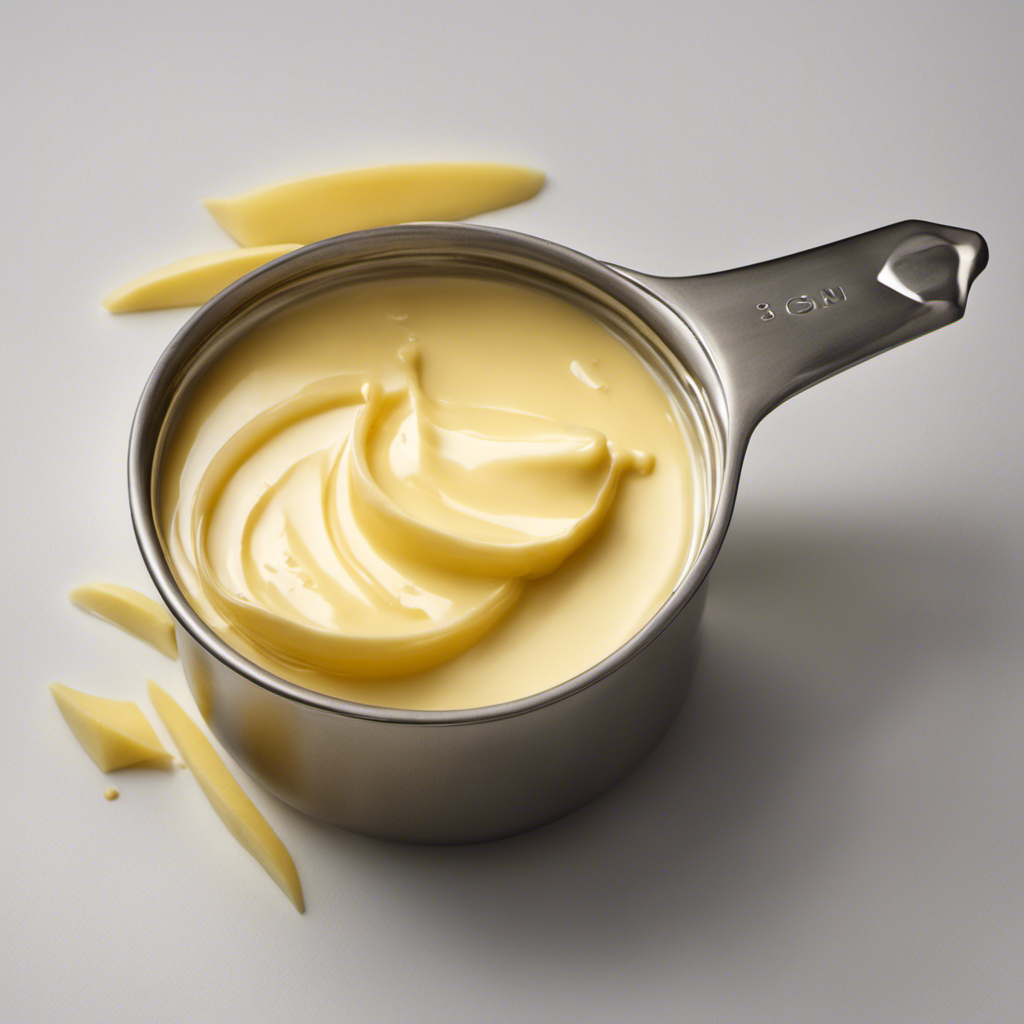
 Butter Tips and Tricks1 month ago
Butter Tips and Tricks1 month agoHow Many Tablespoons in 2/3 Cup of Butter?
-
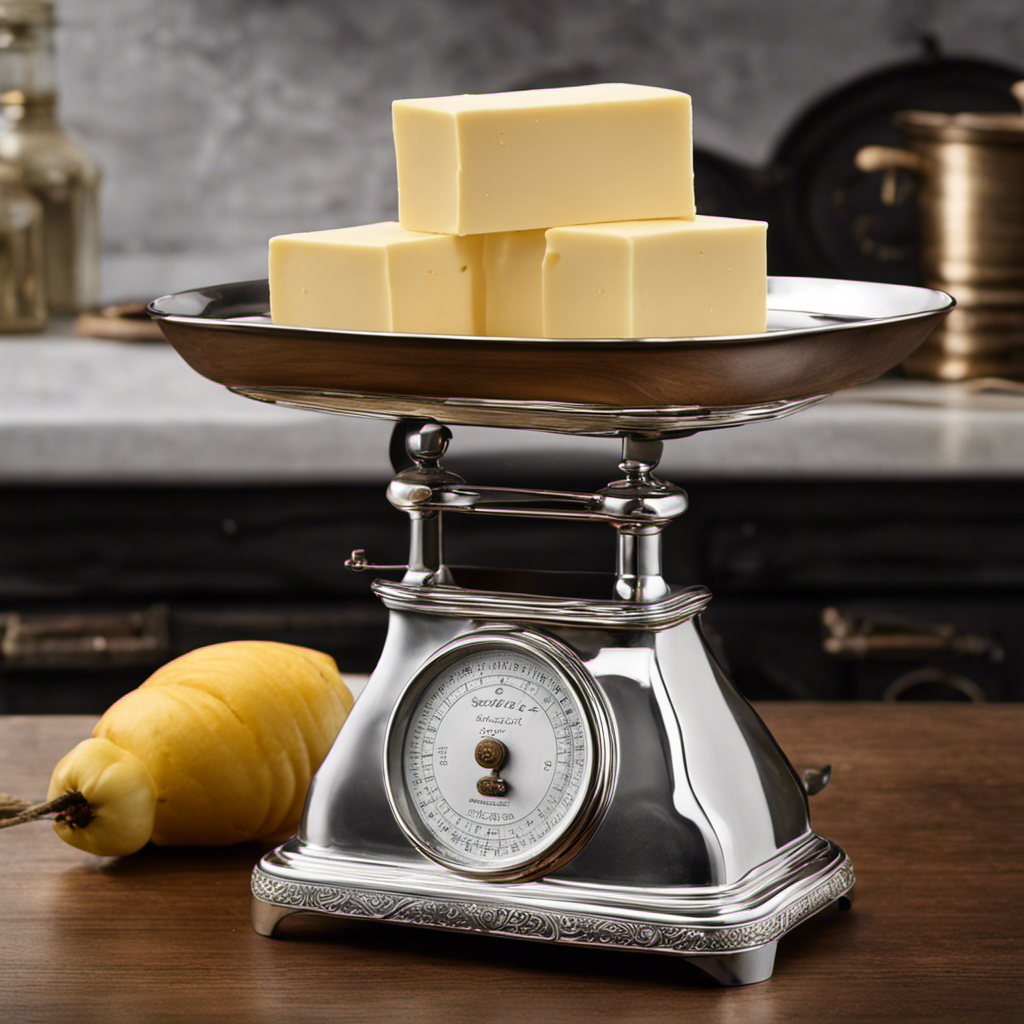
 Butter Tips and Tricks1 month ago
Butter Tips and Tricks1 month agoConverting 3/4 Cup of Butter to Sticks: How Many Sticks?
-
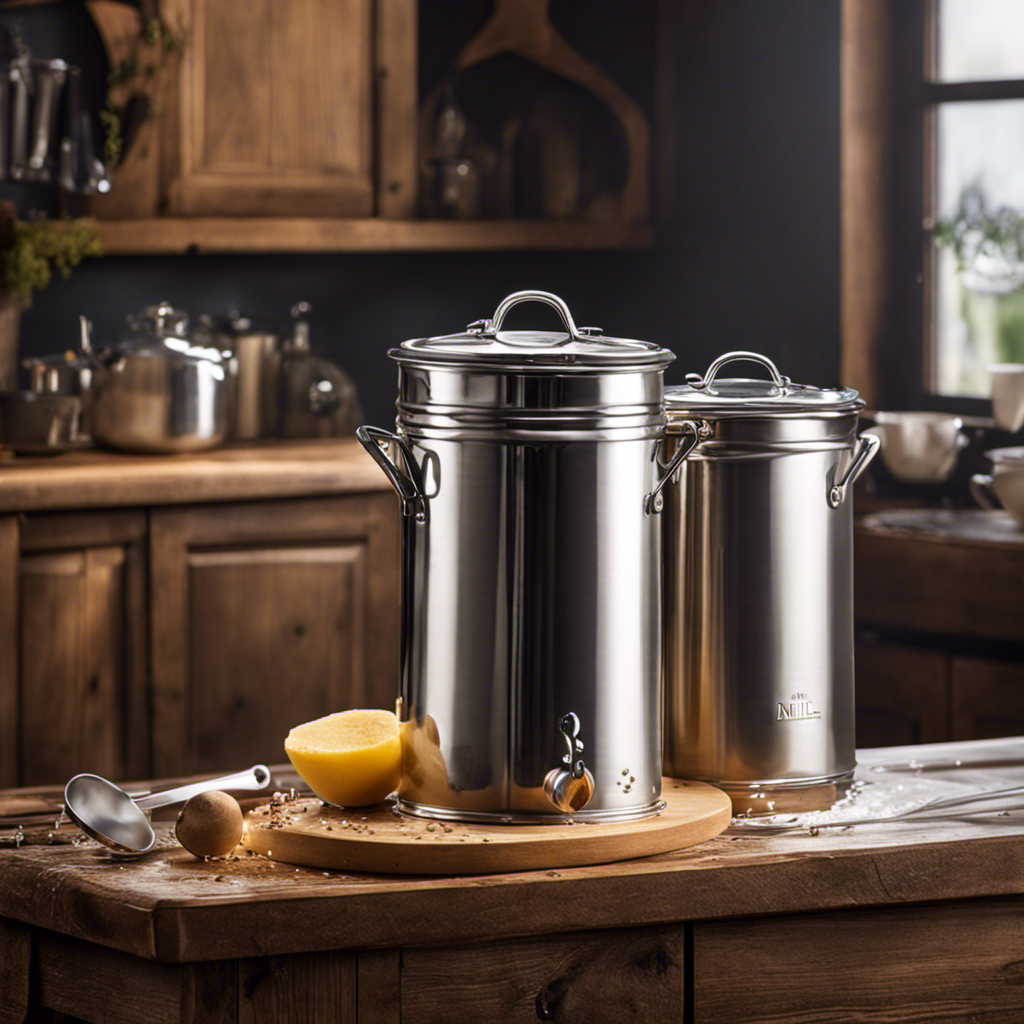
 Recipes & Culinary Uses3 months ago
Recipes & Culinary Uses3 months agoHomemade Butter Making at Home with Fresh Milk
-
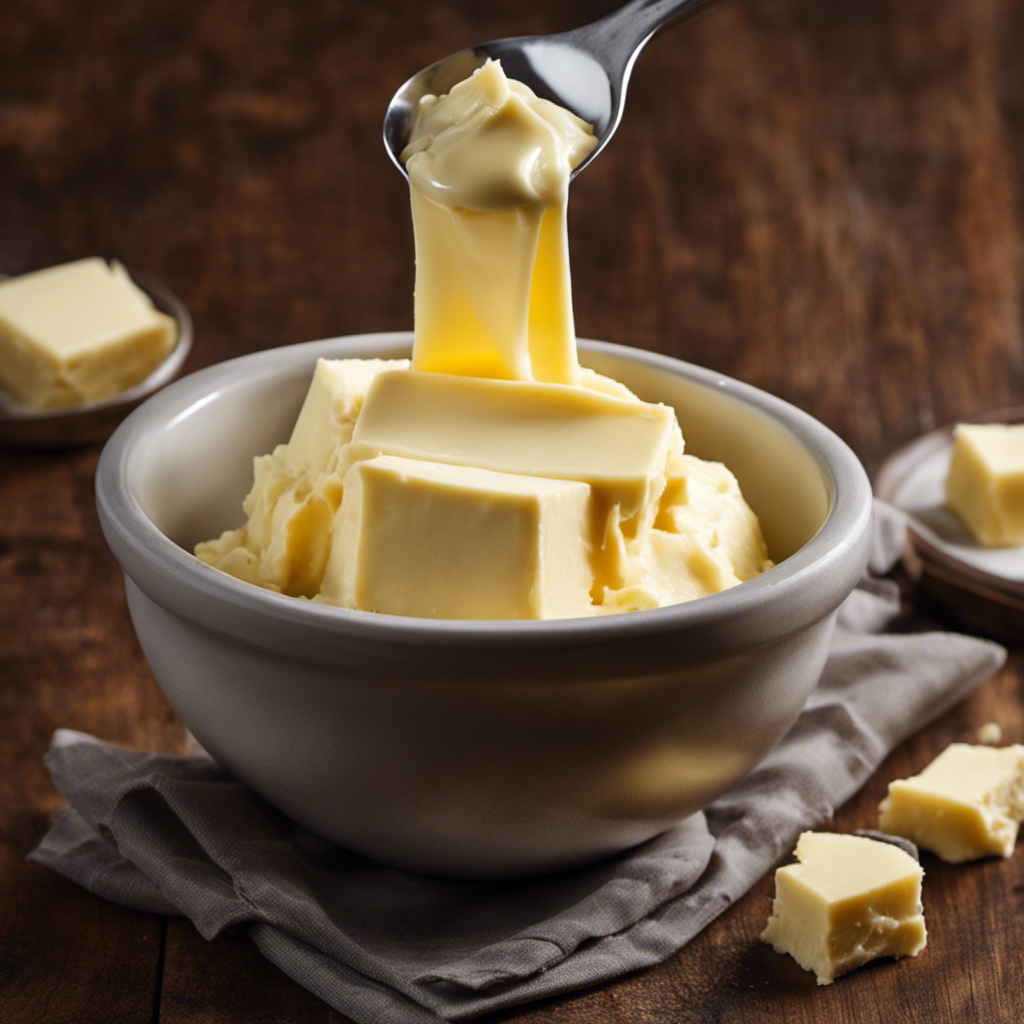
 Butter Tips and Tricks4 weeks ago
Butter Tips and Tricks4 weeks agoHow Many Tablespoons of Butter Are in 3/4 Cup?
-

 Recipes & Culinary Uses3 months ago
Recipes & Culinary Uses3 months ago10 Steps to Cook Delicious Dried Butter Beans
-
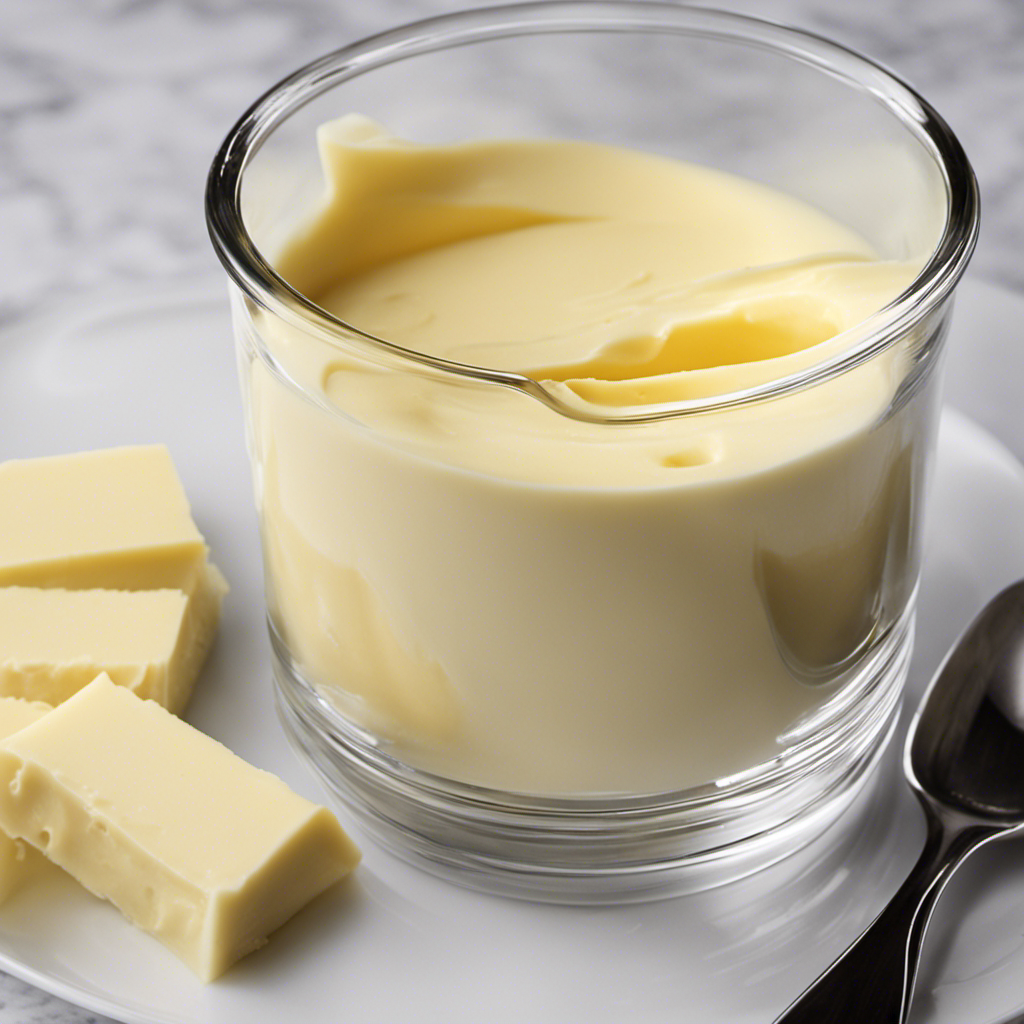
 Recipes & Culinary Uses3 months ago
Recipes & Culinary Uses3 months agoHow Many Tablespoons of Butter in 3/4 Cup: A Simple Guide
-
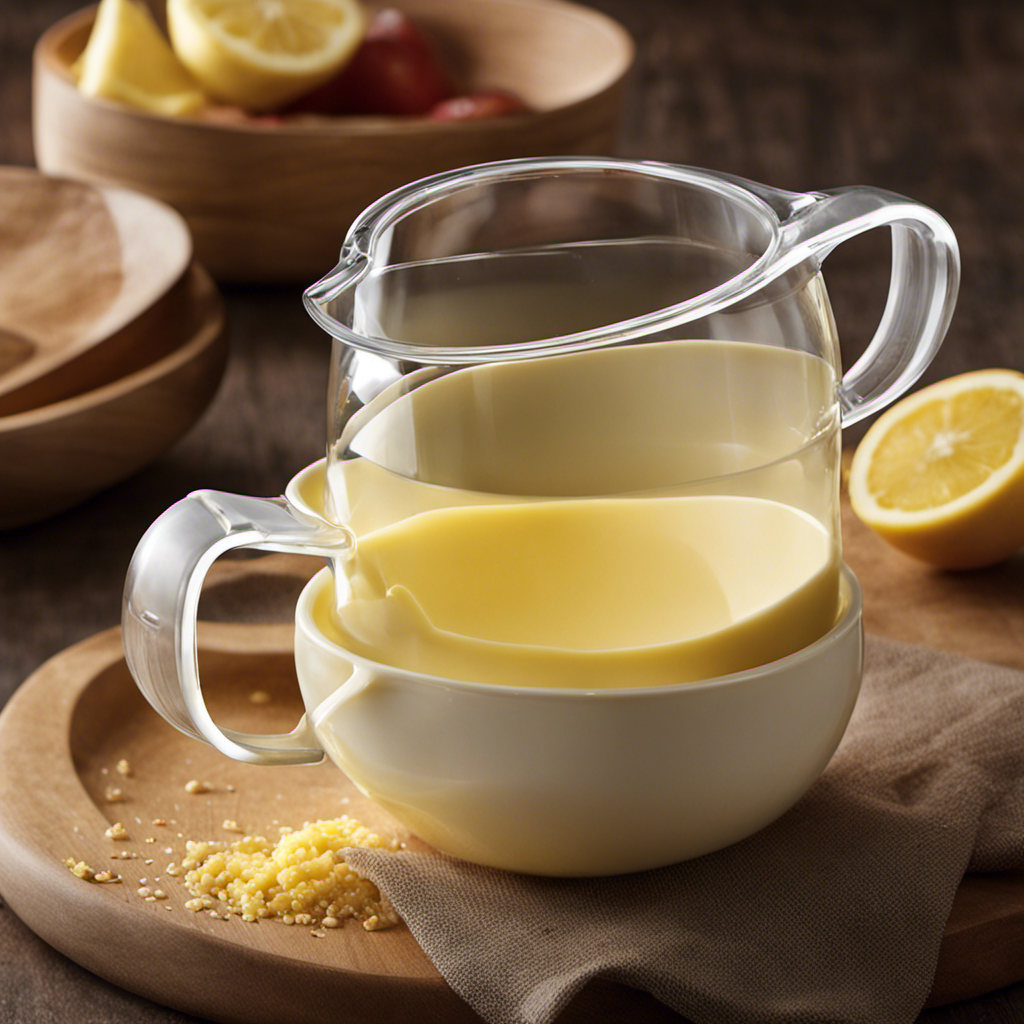
 Butter Tips and Tricks1 month ago
Butter Tips and Tricks1 month agoHow Many Tablespoons of Butter in 1/3 Cup: A Simple Guide
-

 Butter Tips and Tricks4 weeks ago
Butter Tips and Tricks4 weeks agoHow Many Tablespoons of Butter in 1/4 Cup: A Simple Guide








